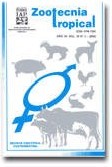
|
Zootecnia Tropical
Instituto Nacional de Investigaciones Agrícolas Venezuela
ISSN: 0798-7269
Vol. 27, No. 4, 2009, pp. 407-417
|
 Bioline Code: zt09043
Bioline Code: zt09043
Full paper language: English
Document type: Research Article
Document available free of charge
|
|
|
Zootecnia Tropical, Vol. 27, No. 4, 2009, pp. 407-417
| en |
Forage production, chemical composition and in vitro gas production of the vegetation of a modulated seasonal savanna
González-Ronquillo, Manuel; Aparicio, Rafael; Torres, René & Domínguez Vara, Ignacio A.
Abstract
In order to characterize forages from a modulated seasonal Savanna. Determination of forage dry matter yield
production (Mg ha-1year), Crude protein (CP), Neutral detergent fiber (NDF), Acid detergent fiber (ADF) and
Lignin (ADL), and in vitro gas production to determine the fermentability and degradability in native forage
samples taken in four seasons of the year: Drought, Drought-Rainy Transition (DRT), Rainy and Rainy-Drought
Transition (RDT) and three physiographical units (Bank, Sandbank and Tideland) was made in a modulated
seasonal savanna in the state of Apure. Venezuela. Pastures performance results varied (P≤0,01) in function to
year's seasons and physiographical units, where the lower offer was in DRT and Drought seasons in comparison
to RDT and Rainy (1,2 and 1,8 vs 3,5 and 3,0 Mg DM ha-1year), in Sandbank unit was lower (P≤0,01) than
Tideland and Bank: 1,8; 2,10 and 2,4 Mg DM ha-1 year-1, respectively. CP content (g 100 g) was higher (P ≤ 0,01) in DRT season (11,84) than the rest (6,6±1,1), in the physiographical units there was no difference (P ≥ 0,05).
The in vitro gas production (ml gas g DM) was in Rainy season (156,89), proceeded by DRT (148,47) with a
difference (P≤0,01) respecting to Drought and RDT, in Tideland it was increased (P≤0,05)(139,10) respecting
to Bank (131,58) and Sandbank (131,80). These results from the usage for a savanna management, the grazing
must be done from December to April (Drought) in the Tideland, from May to June (DRT) in the Sandbank, from
July to September (Rainy) in the Bank, and September up to November (RDT) in Sandbank unit. It is desirable
to consider the forage yield and nutritive quality of the forage for a better usage it.
Keywords
chemical composition, digestibility, forages, modulated savanna, savannas, season, In vitro gas production, forage yield.
|
| |
| es |
Producción de biomasa, composición química y producción de gas in vitro de la vegetación de una sabana estacional modulada
González-Ronquillo, Manuel; Aparicio, Rafael; Torres, René & Domínguez Vara, Ignacio A.
Resumen
Con el fin de caracterizar los forrajes naturales provenientes de una sabana estacional modulada, se determinó la
producción de materia seca (Mg ha-1año-1), proteína cruda (PC), fibra detergente neutro (FDN), fibra detergente
acido (FDA), lignina (LAD) en las muestras de forrajes, así como la producción de gas in vitro para medir
su fermentación y degradación en muestras de forrajes nativas tomadas en cuatro épocas del año: Seca (S),
Transición Seco-Lluvia (TSLL), Lluvia (LL) y Transición Lluvia-Seco (TLLS) en tres unidades fisiográficas
(banco, bajío y estero) en una sabana estacional modulada del estado Apure, Venezuela. Los resultados del
rendimiento de las pasturas vario (P ≤ 0,01) en función de las épocas del año (EA) y unidades fisiográficas (UF)
donde la menor oferta fue en las épocas de TSLL y S en comparación a TLLS y LL (1,2 y 1,8 vs 3,5 y 3,0 Mg
MS ha-1 año-1), en la unidad de bajío es menor (P≤0,01) a las unidades de estero y banco: 1,8; 2,10 y 2,4 Mg
MS ha-1 año, respectivamente. El contenido de PC (g 100g) fue superior (P ≤ 0,01) en la época TSLL (11,84)
con respecto al resto (6,6±1,1), en las UF no hubo diferencias (P ≥ 0,05). La mayor producción de gas (ml gas
gMS) fue en la época de LL (156,89) seguida por TSLL (148,47) con diferencia (P = 0,01) respecto a las épocas
S y TLLS, en el estero se incrementó (P≤0,05) (139,10) respecto al banco (131,58) y bajío (131,80). Desde el
carácter de uso para el manejo de la sabana, el pastoreo se debe realizar de diciembre - abril (S) en el estero, de
mayo a junio (TSLL) en el bajío, de julio a septiembre (LL) en el banco, de septiembre a noviembre (TLLS) en
la unidad de bajío. Se recomienda considerar la producción de biomasa y la calidad nutritiva del forraje para un
mejor aprovechamiento.
Palabras-clave
sabana, estación, sabana modulada, forrajes, producción, composición química, digestibilidad, producción de gas in vitro.
|
| |
© Copyright 2009 - Zootecnia Tropical
Alternative site location: http://www.sian.inia.gob.ve/repositorio/revistas_ci/ZootecniaTropical/ztindice.htm
|
|
